Ride-On tire sealant and balancing gel is a product designed to enhance the lifespan and performance of a vehicle’s tires. The product consists of two components: tire sealant and balancing gel.
The tire sealant is a liquid added to the inside of the tire through the valve. It coats the inner surface of the tire and seals any leaks that may occur while driving. This eliminates the need for the driver to worry about unexpected leaks and tire replacements. Ride-On also offers a warranty for this, promising a replacement if the leak falls within normal parameters but remains unsealed.
The balancing gel is intended to evenly distribute the weight of the vehicle across the tire, reducing uneven wear and unwanted vibrations while driving. This enhances ride comfort and handling, thereby increasing driving pleasure and safety. The Ride-On tire sealant and balancing gel can be installed by a professional or by the owner at home. Ride-On is designed as a long-term solution for tire issues, not just a temporary fix.
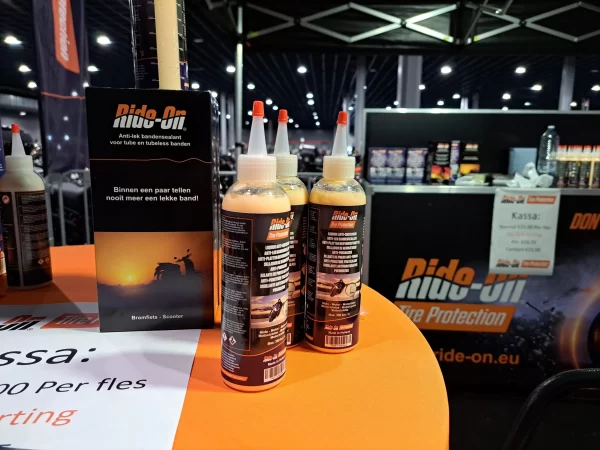
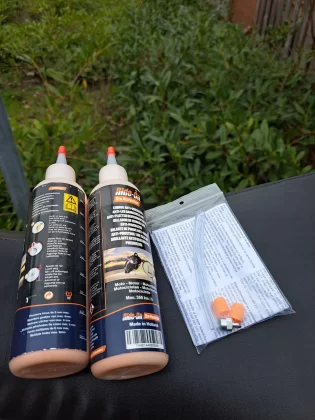
What is Ride-On really?
Ride-On is both a tire balancer and a sealer combined into one product, remaining liquid as long as it stays within the tire. This applies to both tube and tubeless tires. It’s important to note that Ride-On contains no glue whatsoever; sealing is achieved without the hardening of a rubber/liquid mixture. In addition to small rubber particles, the gel contains an aramid fiber called Twaron fiber. Despite its microscopic size, this fiber is six times stronger than steel. While the gel primarily serves as a carrier for these fibers, it also aids in balancing the tire. As you drive, the natural forces of motion cause the gel to spread evenly, helping to balance the tire. As a result, the gel only reaches the tread area of the tire. The advantage is that the rim remains clean and unaffected, while the disadvantage is that not the entire tire is protected. The region left unprotected by Ride-On roughly corresponds to the area that, depending on the tire and tube size, may legally not be repaired. This is one of the reasons why Ride-On is a permanent sealer rather than a temporary fix.
A third function of the gel is to reduce the porosity of the tire where the gel comes into contact with it. As a result, the tire maintains pressure for a longer period, leading to better air pressure and less tire wear. Ride-On claims that this can make up to a 25% difference for trucks, but in my experience with motorcycles, due to the smaller surface area, the difference is much less significant. Of course, maintaining proper tire pressure is crucial for tire wear. Realistically, this may result in around a 5% difference, which may be negligible. On the other hand, this is a nice addition, but not the primary reason for using Ride-On.
Many motorcyclists who use Ride-On seem to do so for safety reasons; a potential leak can be fixed on the go, restoring tire pressure and allowing them to continue their journey. Comfort is also frequently mentioned, as the constant balancing effect of Ride-On makes for a smoother ride. Some use Ride-On for cosmetic reasons, as the balancing effect eliminates the need for wheel weights on the rim. During prolonged periods of inactivity, such as winter months, it is advised to drive a bit more cautiously for the first few kilometers to allow Ride-On to redistribute evenly throughout the tire. In practice, after three weeks of inactivity, just a few streets were enough to noticeably allow Ride-On to properly balance the tire again.
If a leak occurs in the tire, the gel is pushed out through the hole, compressing it and causing the various Twaron fibers to come into contact with each other. Due to the shape and properties of these Twaron fibers, they adhere to each other and to the rubber of the tire. This adhesion forms a bond that Ride-On claims is “6 times stronger than steel.” As a result, after sealing, the patched hole is stronger than the surrounding rubber. According to Ride-On, any remaining Ride-On in the tire can be removed after sealing a puncture, but the patched hole will remain sealed. Of course, it’s advisable to keep Ride-On in the tire to address any future leaks.
Use in case of a flat tire.
The correct amount of Ride-On should be inserted into the tire. It’s best to manually rotate the tire a few times afterward to ensure even distribution within the tire. Next, reflate the tire to normal air pressure, and it’s advised to take a short ride. While riding, a tire performs two functions. The tire deforms upon contact with the road surface, causing the hole in the tire to deform slightly, allowing the Ride-On to fill it optimally. Additionally, the speed of riding creates centrifugal forces, spreading the Ride-On over the tire and pushing it out through the hole.
Dealers often have larger barrels or containers available, which offer convenience and cost savings for larger quantities. For private use, convenient bottles can be ordered, with an average of 2 bottles typically sufficient for 2 tires. Larger tires may require a third bottle. Ride-On provides a handy calculator on their website for this purpose. Enter your tire’s dimensions, with or without an inner tube, and it will calculate the required quantity in millimeters. The bottles themselves also indicate the recommended quantity for accurate dosing, potentially rounded as needed.
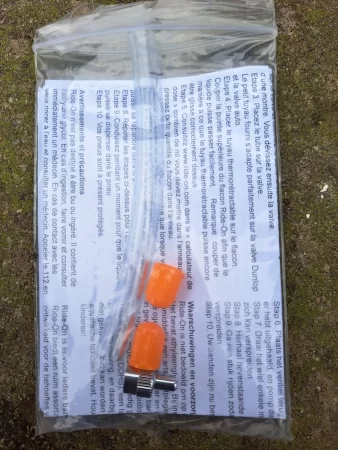
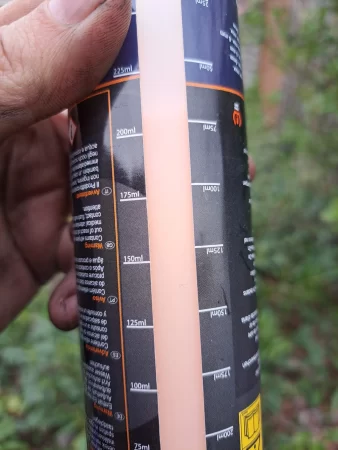
My personal experience
A more personal story than usual. In 2020, after multiple flat tires, I found myself with another punctured rear tire. Fed up with having to replace tires, I decided to do some googling. That’s when I came across Ride-On, a name that sounded familiar to me, so I thought to myself, ‘Let’s just give it a try.’ Following the proverb ‘Assertive people have half the world,’ I emailed Ride-On and explained the situation. As it turned out, a collaboration seemed to be possible.
So, one Saturday morning, someone from Ride-On came by to fill the rear tire with the correct amount of Ride-On on-site. With the camera rolling, I filmed the process for YouTube and wanted to see if and how it worked. It was all quite simple. First, I removed the screw from the rear tire to let out the last bit of air from the inner tube. Then, Ride-On was applied through the valve in the measured amount, depending on the tire size and whether or not there was an inner tube. My XT660 naturally has an inner tube, so that needed to be taken into account. The rear tire was slightly inflated, and while I lifted the XT660 off the ground, the technician spun the rear tire a few times. As the Ride-On started to emerge from the hole in the rear tire, the air pump was connected again to inflate the rear tire to the correct pressure. I was personally amazed at how quickly the puncture was sealed.
Once inflated, I was asked to ride around for about 5 minutes to allow the Ride-On to spread properly and seal the puncture. So, I put on my helmet and took off. Starting cautiously, but gradually picking up speed. Upon returning home, the technician loaded most of the equipment back into the van, and we inspected the tire. There was still a bit of Ride-On visible where the puncture was, but any excess had been neatly removed. So, the tire pressure was adjusted back to the correct level, only losing 0.1 bar, and we shook hands firmly to conclude this experience. And then came the test…
I rode on the rear tire in question until the tread was no longer legal, and the repaired puncture remained sealed. I didn’t notice much difference in balancing technique; the bike is used all year round, so there’s no prolonged periods of inactivity. However, occasional weeks of inactivity do occur, and I never noticed the presence of Ride-On.
I had a new rear tire installed, along with a new inner tube. After a few weeks, I decided to order Ride-On again, this time as a preventive measure. I added Ride-On to the rear and front tires at a gas station and removed the ‘unsightly’ balancing weights upon returning home. Let’s see how that goes. On the next working day, I rode to work with the XT, and initially, I thought I felt something on the first few meters of the highway, but soon everything was smooth again. Maybe it was just my imagination, but I rode without weights for the entire year. At some point, I ended up with a flat rear tire again. Upon inspecting the tire, I found a very small leak. I wiped away the Ride-On, inflated the tire, and resumed riding. However, I experienced another flat tire. Ultimately, I had a new inner tube installed, and together with the garage, we examined the old inner tube. It turned out that there was still a small nail in the rear tire. Not visible from the outside, but it had punctured the inner tube multiple times in a relatively small area. Despite Ride-On’s attempts to seal all the holes, this proved to be too much for it.
Naturally, a new inner tube was installed, and I applied Ride-On once again. At the time of writing, this rear tire is almost legally done and will be replaced with a new rear tire. With a fresh dose of Ride-On.
A long personal story, from the great success of sealing the first major leak to the exception where Ride-On didn’t work. And everything in between. In any case, I haven’t received any complaints from the dealer about mess during tire replacement. Additionally, no more weights on the rim. It looks tidier and saves time cleaning. Whether tires with Ride-On last longer is difficult to say, as I haven’t compared tires with and without Ride-On of the same brand/type.
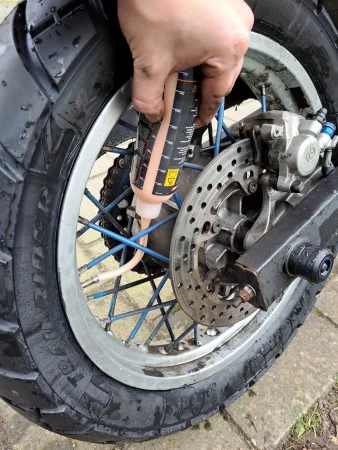
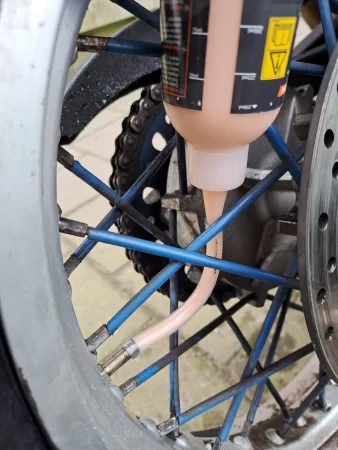
Conclusion
Ride-On promises a lot, and based on personal experience, I can confirm some of what is promised. The main reason many users will want to purchase it is for tire sealant. Whether as an emergency option under the seat or as a preventive measure in the tires, I can note that it worked for me, even with inner tubes.
The balancing gel does its job well enough that all wheel weights can be removed. As for whether the tires stay inflated longer, I believe they do, but I don’t check tire pressure often enough or regularly enough to say anything meaningful about it. The only difference I noticed is that my front tire without Ride-On always had less pressure than the rear tire with Ride-On. Meanwhile, Ride-On is now in both tires.
Directly achieving fuel efficiency is difficult to determine. Despite the sporty riding style, I found the XT to be quite fuel-efficient, averaging between 1 in 18 to 1 in 20. Improving rolling resistance and reducing vibrations and noise cannot be assessed while riding. The XT660 naturally vibrates as a single-cylinder anyway. Reduction in wear due to stabilization will vary depending on the type of motorcycle and/or car.
Is the investment of 25 to 50 euros worth it on a set of tires totaling at least three hundred euros? That will vary from rider to rider. With current gasoline prices, any savings on fuel can help. I will definitely balance the next motorcycle tire with Ride-On.
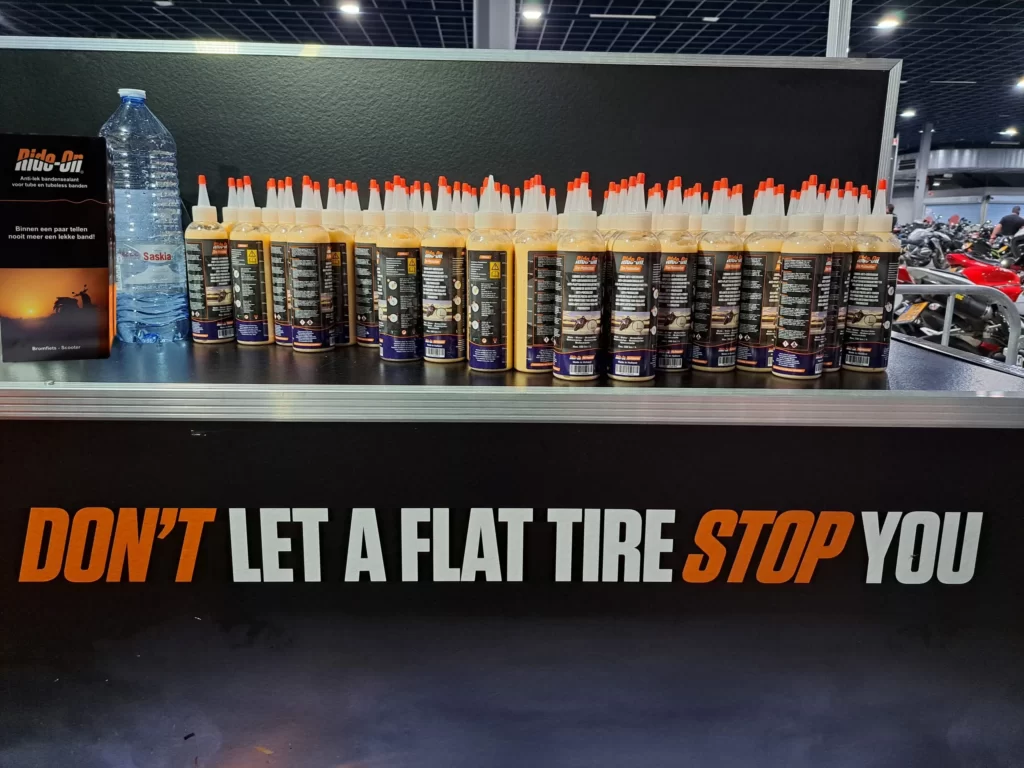
Meer Posts
Custom Seat Upholstery (2024)